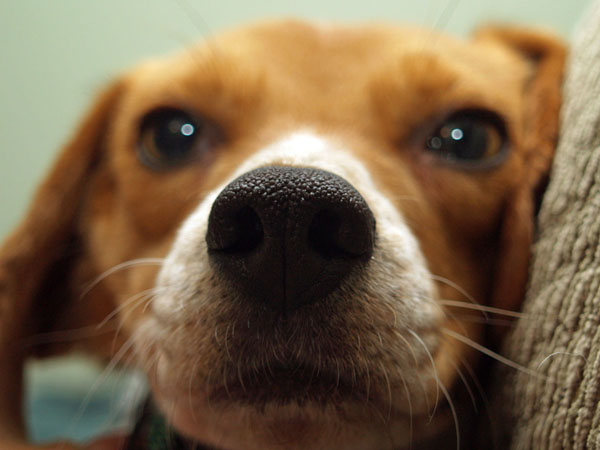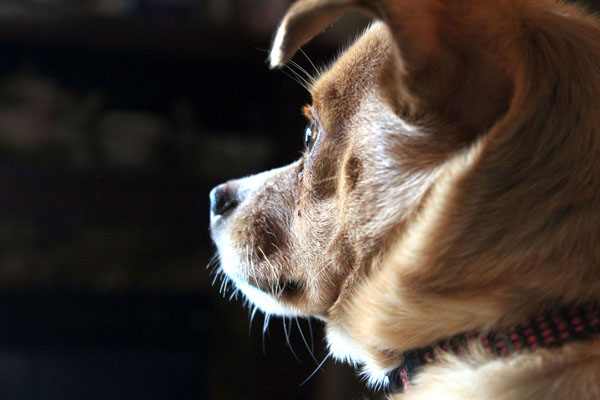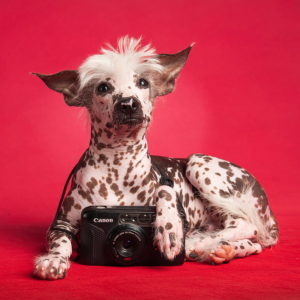Everyone knows cats have whiskers. Even hairless breeds have four neat rows on either side of their face. And, odds are, you’ve heard a few lectures on the importance those whiskers serve to the feline species. They’re a critical part of a cat’s anatomy. But if you spend time petting your dog’s face, you might notice whiskers there, too. They’re not in rows. In fact, they seem to sprout all over. And if you’ve looked at different breeds, there’s no rhyme or reason to the placement. So what’s going on with dog whiskers? Do they act the same as cat whiskers? Or do they serve a different purpose? And why aren’t they as consistent in canines as they are in felines? If these questions are keeping you awake at night, fear not. We have all of the answers to let you rest easy.
Vibrissae
Whiskers pop up in A LOT of mammals – not just cats and dogs. Also known as vibrissae, whiskers are specialized hairs. They sit within a hair follicle, but the roots go THREE times deeper. The follicle also has more blood vessels and nerves, which is important since whiskers are thicker and have a coarser texture than your average hair. (If you’ve ever touched one, you can feel the difference)
Inside those follicles, you find special skin receptors known as Merkel cells. Merkel cells work to collect tactile (touch) sensations. This is why whiskers are also known as “tactile hairs.” And the highest concentration of Merkel cells in dogs shows up around dog whiskers. This includes (in general) the areas above the eyes, the sides of the snout, above the lip, and under the chin. They’re the FIRST hairs dogs develop, showing up as soon as a puppy’s born.

Dog Whiskers
Unhappily, that’s where the similarity ends. Dogs don’t have the same pattern of whiskers as cats. Between breeds, the placement of dog whiskers varies. (As you might expect. A brachycephalic breed, such as a Pug, has a much shorter snout than a Greyhound) And some of the hairless dog breeds may not have whiskers at all! It depends on how much hair they have on and around their face.
So if there’s no consistency in the canine world, what do dog whiskers DO? They’re clearly not decoration if they have that blood and nerve supply sitting at the base of the hair follicle – right?
As it turns out, those thick vibrissae serve several purposes for your pup. Probably more than you thought possible!
Dog Whiskers: “Vision”
We know dogs have fantastic senses of smell and hearing. But when it comes to sight, they come up short – literally. Your dog can see the other side of the yard better than the food bowl at their feet. That concentration of dog whiskers around their face helps give them a better idea of the world close to them.
As air currents or outside pressures move a whisker, the hair vibrates in the hair follicle. The movement is translated to those Merkel cells which carry the information to your dog’s brain. FORTY percent of a canine’s sensory brain is devoted to processing details from the whiskers. And researchers have proved individual vibrissae trace to specific spots. This allows your dog to use all of their whiskers and create a detailed image of the area immediately around their face. (Which is pretty cool, when you think about it) All of those dog whiskers go to work, collecting vibrations and acting as a sort of radar system. They’re so sensitive the tiniest breeze or fleck of dust can set them off. (And if you touch one, you’ll see your dog blink)
As a result, your dog can find their food bowl without a problem. Or they can snatch a favorite toy from the toy box. The whiskers step in where their far-sightedness fails them.

Dog Whiskers: Environmental Perception
Your dog collects a lot of information as they explore the outside world. They take in smells, sounds, sights, and additional information. How close is that frisbee? What’s the speed of the tennis ball that flew by? How far is that quail settling down in the grass? This is the kind of processing dog whiskers were designed to gather.
Anything moving moves the air around it. And the resulting air current is communicated to vibrissae. Merkel cells and your dog’s brain can figure out the speed AND size of the moving object as a result. Wolves need the skill when they’re hunting to help them locate and determine the size of their prey. And this skill makes many hunting breeds the champs they are. Even the slightest change in the environment translates to dog whiskers, letting them focus on the object or prey. Or it can simply help them snatch that frisbee or tennis ball out of the air with precision. Remember, they’re going to lose sight as they get closer. Dog whiskers help them stay on track, even as things go out of focus.
Dog Whiskers: Navigation
If you look closely, you’ll notice that dog whiskers (typically) stick out the exact width of your dog’s body. That isn’t a coincidence. Like cats, it’s an evolutionary design to allow your canine to pass through narrowed spaces without a problem. That handy built-in radar system prevents your pup from getting stuck.
As a dog gets close to a “tunnel” (which may be the space between your couch and the wall), air currents get stronger between the surfaces. The air then strikes the whiskers, sending an important message to your dog’s brain. Either it will tell them they can fit past the opening, or it’ll let them know things are too tight. It’s beneficial at night. Dogs can see in dim lighting conditions, but full darkness is difficult. Add in a nearby navigation issue, and those dog whiskers are a life-saver. (Okay, maybe nothing that extreme, but it’ll save them the embarrassment of getting wedged in the ottoman)

Whisker Safety
As an “ordinary” hair, many people overlook dog whiskers during the grooming process. And if you accidentally cut a whisker, you won’t cause any pain. As with any other hair, there aren’t any nerves inside of the vibrissae. However, you’ll leave your dog feeling out-of-step with their world, especially if you trim A LOT of whiskers. They’ll lose an important communication source with their surroundings. You may see them miss things directly under their head. They may hesitate to pass between objects. Or they may not want to engage in ANY normal activities. You’ve taken away part of their senses, and until they regain a semblance of normalcy, they’ll feel reluctant.
NEVER pluck a whisker. That DOES hurt. Remember, there ARE nerves at the base of the hair follicle. Your dog won’t appreciate the process OR the result.
Vibrating Around
It’s amazing how a tiny vibration can communicate so much information. Dog whiskers play a crucial part in how they view and interact with the world around them. But as your dog sleeps, so do those vibrissae. It gives the Merkel cells and the doggie brain a chance to rest and recover.
So the next time you see those whiskers arch up in interest, marvel at all of the work they’re undertaking. And maybe wonder what the air currents are reporting about you!













No comment yet, add your voice below!